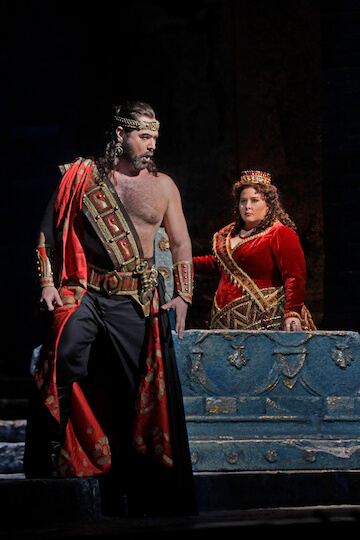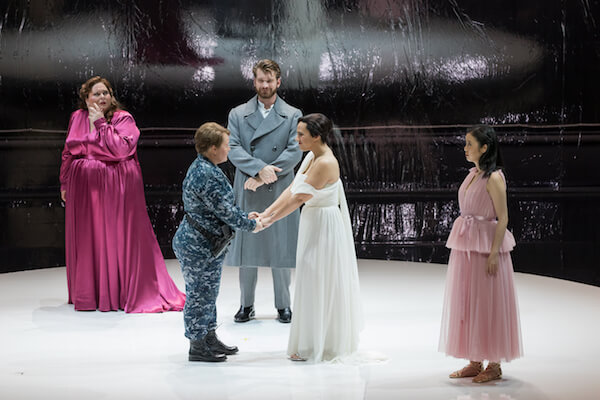Santiago Ballerini and Angela Meade in the “Bel Canto at Caramoor” opera concert of Vincenzo Bellini’s “Il Pirata.” | GABE PALACIO
Will Crutchfield’s “Bel Canto at Caramoor” series celebrated its 20th and final season this summer. During those 20 years, Crutchfield has ventured through Bellini, Donizetti, and Rossini with side trips into Gluck, Poulenc, Beethoven, and Verdi.
Often, these operas were heard in critical editions curated by University of Chicago Professor Philip Gossett and his colleagues. Gossett passed away last month, and many attendees fondly remembered his informative and enlightening pre-performance lectures.
For the farewell “Bel Canto at Caramoor” opera concert, Crutchfield chose Vincenzo Bellini’s early breakthrough opera “Il Pirata” (1827), which was performed on July 8. The gala opening night concert was held on June 17. Soprano Angela Meade and tenor Santiago Ballerini headlined both evenings. These two singers got early career boosts from Crutchfield at Caramoor. Meade debuted in the title role of Rossini’s “Semiramide” in 2009 and followed that up the following summer with her triumphant first professional performance of the title role of “Norma.” Meade will sing both Semiramide and Norma next season at the Metropolitan Opera. Argentinian Ballerini was only a few years into his career when Crutchfield chose him to sing Fernand in “La Favorite” in 2015 for his American debut.
Angela Meade’s cascades of coloratura, Santiago Ballerini’s assured sweetness highlighted
This summer, Meade reaffirmed her bel canto credentials while displaying stronger dramatic temperament and a growing voice ready to take on new challenges. Hinting perhaps at a change of career direction, she explored the spinto and dramatic repertoire in the opening night gala.
In “Pace, pace mio Dio” from “Forza,” Meade used a broad palette of dynamics and colors but the musical phrasing sometimes sounded gusty rather than sweeping. She sang Isolde’s “Liebestod” quite audibly and beautifully with a warmer tone than we are used to (no need to temper any vocal steel in the timbre). “Ebben, ne andrò lontano” from Catalani’s “La Wally” was possibly her best work of the evening. In all three arias, Meade startled with her uninhibited use of chest tone in the lower phrases, but in the “Wally” aria it was better integrated with the rest of her voice.
Ballerini, not yet 30, returned after two years a refined, technically assured artist. At his Caramoor debut, Ballerini’s Fernand was promising and sweetly lyrical but lacked finish and confidence. At last month’s gala, Ballerini strode out with a technically secure, soaring version of Arturo’s cavatina “A te, o cara” from Bellini’s “I Puritani.” The high C’s and D’s were heady but firm, blossoming out of an elegantly sculpted vocal line. Ballerini offered nine brilliant high C’s in Tonio’s showpiece “Pour mon âme, quel destin” from Donizetti’s “La Fille du Régiment.” Stylishly shaped legato phrasing marked his contribution to the duet “Bagnato dalle Lagrime” from “Il Pirata” with the confident, bright-voiced soprano JoAna Rusche as Imogene (Rusche is Meade’s cover).
Bass Harold Wilson strutted heartily through the “Air du Tambour-Major” from Thomas’ “Le Caïd,” with range and voice to burn (but without the bel canto finesse of the legendary Pol Henri Plançon). Teresa Castillo confidently delivered the Queen of the Night’s rage aria “Die Hölle Rache,” but Robyn Marie Lamp was loud and out of tune leading the sextet from “Lucia di Lammermoor” with other young artists. Overtures, choruses, and ensembles from “Guillaume Tell,” “Cavalleria Rusticana,” and “Nabucco” rounded out the concert, deftly handled by maestro Crutchfield and the Orchestra of St. Luke’s.
“Il Pirata” was a rousing and moving evening of Romantic music drama playing to a full and wildly appreciative audience. Though in recent decades the opera has been viewed as a soprano vehicle (Maria Callas reintroduced the opera in a 1958 La Scala revival and Montserrat Caballé took over the role of Imogene in the 1960s), it was originally a tour de force for tenor Giovanni Battista Rubini as the titular pirate Gualtiero. Meade’s commanding, dramatically engaged Imogene was equally matched by Ballerini’s ardent, stylish and dashing Gualtiero.
Meade’s large flexible soprano was not without a few awkward seams and glitches. Her open-toned upper middle has a noticeably wider vibrato than the rest of the voice. Meade’s upper register still extends up to easy high D’s but her ethereal pianos sound like a disconnected trick falsetto. This often required her to break the vocal line before the piano note, calling attention to the effect.
Everything came together thrillingly however in Imogene’s mad scene “Col sorriso d’innocenza… Oh sole, ti vela!” Meade sang the cavatina with lush fine spun tone then tore into high notes and plunged into low notes with exciting abandon in the cabaletta. She scrupulously polished each note of the wide-ranging scales.
Ballerini sings wonderfully on the breath, applying expressive light and shade to the musical line. His upper register is easy and sweet, sailing effortlessly up to the many C’s and D’s required in this virtuoso tenor role. A little more control over his mezza voce singing is needed but at least he does attempt to sing softly. Slim and compact with a handsome face, Ballerini cuts a romantic figure onstage.
Wilson as Imogene’s unloved husband and Gualtiero’s arch enemy Ernesto sang with imposing tonal thrust and confidence with a rock solid high F; for a bass he handled this baritone role with surprising ease. Excellent support was provided by soprano Lamp, tenor Sean Christensen, bass-baritone Joseph Beutel, and the Bel Canto Young Artists chorus. Crutchfield and the Orchestra of St. Luke’s presided over a colorful, rousing interpretation of Bellini’s youthful blood and thunder score. Crutchfield masterfully used rhythm and color to point up the drama and pull the listener through a few dull passages in Bellini’s uneven score.
In July 2018, Crutchfield will move down the road to the Performing Arts Center at SUNY Purchase College, leading the inaugural season of “Teatro Nuovo” (teatronuovo.org), a nine-day music festival that will include semi-staged performances of Mayr’s “Medea in Corinto” and Rossini’s “Tancredi.” Next year’s festival runs from July 28 through August 5. One door closes and another opens.
Last month, BAM presented the New York premiere of “Three Way,” a trio of one-act operas with music by Robert Paterson and libretto by Time Out New York critic David Cote. This sassy trio of one-acts in the key of sex is a co-presentation of Nashville Opera, American Opera Projects, and the American Modern Ensemble.
Samuel Levine, Danielle Pastin, and Wes Mason in “The Companion,” Act I of “The Three Way.” | ANTHONY POPOLO
Each opera deals with sexual experimentation, boundaries, and roles in the 21st century. The overall theme involves the difficulty of human communication and connection in a world where technology could bring us closer together but instead creates barriers. Sexual freedom breaks down social prohibitions but can lead to difficult choices, new barriers, and conflicts.
In “The Companion” an unmarried, overextended career woman Maya (smoky-toned soprano Danielle Pastin) purchases her ideal mate — a biomorphic computerized android, Joe. Joe (wittily sung by lyric tenor Samuel Levine) caters to her every need, even providing cybersex in three dimensions, but he has no personality of his own, no spontaneity, no real behavior. Technician Dax (virile barihunk Wes Mason) upgrades his software and Joe goes from perfectly groomed, subservient male concubine to slobbish, neglectful, and combative live-in boyfriend. The realism gets to be too much for Maya, and Joe suggests that techie Dax might be the ultimate fix for her male companionship needs.
Three sex-themed one-acts out of Nashville
Cote’s libretto is clever in a Ray Bradbury meets Camille Paglia way, taking satiric shots at both the male and female perspectives. Also targeted is the 21st century fixation on cyberspace as a central area of social interaction — our dependence on smart phones for communication. Apps like Grindr, Scruff, and Tinder have replaced going to bars to actually meet flesh and blood people for sex.
Paterson’s music (played by the American Modern Ensemble stationed in the side balconies above the stage) is spiky, layered, but lyrical with the voices front and center. Paterson makes musical and thematic nods to such canonical works as “The Tales of Hoffmann,” “Salome,” and “Così fan tutte” but finds his own contemporary voice. The vocal writing in each opera is dominated by extended recitative that never becomes boring or repetitive as Paterson knows how to vary the musical language to suit situation and character. In all three operas, each of the protagonists gets a vocal solo to explore their emotional needs and inner world.
The middle piece, “Safe Word,” deals with a dominatrix (mezzo Eliza Bonet) locked in a game of sexual dominance and control with an entitled douchebro businessman client (bass Matthew Treviño). This one has a twist in the tail that is more than clever –– it adds complexity to the theme of role-playing and control.
Role-playing is explored further in Act III “Masquerade” where four couples explore fluidity of sexual identity, shedding their external personas at a masked and darkened sex party. “Masquerade” makes explicit references to Mozart’s “Così fan tutte” as three younger couples swap partners, learning more about themselves under the guidance of a more sexually knowing older couple. This was one piece where same sex attraction was explored in the guise of post-gender couple Tyler and Kyle (mezzo Melissa Bonetti and countertenor Jordan Rutter done up as androgynous boho twins). Rutter was particularly beguiling as the insecure, needy Kyle while Pastin and Mason scored as a pair of aging swingers.
Paterson and Cote never judge the characters or their choices — their common humanity is amplified by the music. Conceived and directed by John Hoomes of Nashville Opera, the production found the right tone for each of the three episodes, never descending into titillation or vulgarity. Hoomes elicited thoughtful, nuanced acting from his youthful cast. Some of the voices were more prepossessing than others but all were deeply invested in the characters and their stories.
Scenic designer Randy Williams created simple but colorfully evocative spaces in the intimate black box Fishman Space. Conductor Dean Williamson, like director Hoomes, was involved in the world premiere production of “Three Way” this past January at Nashville Opera. From his front row center seat podium, Williamson led a performance of tremendous authority and depth. “Three Way” had no difficulty connecting with the BAM audience and deserves a further life in opera houses, conservatories, and chamber companies in need of a smart contemporary work.




































